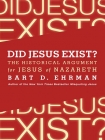Did Jesus Exist? - The Historical Argument for Jesus of Nazareth Bart Ehrman (books to read in your 20s txt) 📖

- Author: Bart Ehrman
Book online «Did Jesus Exist? - The Historical Argument for Jesus of Nazareth Bart Ehrman (books to read in your 20s txt) 📖». Author Bart Ehrman
And it helps explain Jesus’s own reaction to his own family. For there are clear signs not only that Jesus’s family rejected his message during his public ministry but that he in turn spurned them publicly (independently attested in Mark 3:31–34 and Gospel of Thomas 99). Jesus clearly saw the familial rifts that would be created when someone became committed to his message of the coming kingdom:
You think that I have come to bring peace on earth; not peace, I tell you, but division. For from now on there will be five people in one house, divided among themselves: three against two and two against three; a father will be divided against his son and a son against his father, a mother against her daughter and a daughter against her mother; a mother-in-law against her daughter-in-law and a daughter-in-law against her mother-in-law. (Luke 12:51–53; Matthew 10:34–46; independently attested in Gospel of Thomas 16)
And family tensions would be heightened immediately before the end of the age, when “a brother will betray his brother to death, and a father his child, and children will rise up against their parents and kill them” (Mark 13:12).
These antifamily traditions are too widely attested in our sources to be ignored (they are found in Mark, Q, and Thomas, for example), and they show that Jesus did not support what we today might think of as family values. But why not? Evidently because, as I have already emphasized, he was not teaching about the good society and about how to maintain it. The end was coming soon, and the present social order was being called radically into question. What mattered was not ultimately the strong family ties and social institutions of this world. What mattered was the new thing that was coming, the future kingdom. It was impossible to promote this teaching while trying to retain the present social structure. That would be like trying to put new wine into old wineskins or trying to sew a new piece of cloth to an old garment. As any wine master or seamstress can tell you, it just won’t work. The wineskins will burst and the garment will tear. New wine and new cloth require new wineskins and new garments. The old is passing away, and the new is almost here (Mark 2:18–22; Gospel of Thomas 47).
Jesus and the Temple
In addition to being opposed to other Jewish leaders and to the institution of the family, Jesus is portrayed in our early traditions as being in severe opposition to one of the central institutions of Jewish religious life, the Temple in Jerusalem. Throughout our Gospel traditions we find multiple, independent declarations on the lips of Jesus that the Temple will be destroyed in a divine act of judgment. As we have seen, the Temple was the locus of all religious practice and authority for most Jews in Jesus’s day. It was there, and there alone, that the sacrifices could be made to God as commanded in the Torah. And since the Temple service was such an enormous affair, the Temple stood at the center of all political, economic, and social life in Jerusalem, the capital city of Judea.
At different periods of ancient history, however, various Jewish prophets believed that the Temple had become corrupted by those who were in charge of it. Some six centuries before Jesus, for example, this was the view of the prophet Jeremiah, whose many rants against the Temple and its leaders led to his abuse and mistreatment by the local authorities (see especially Jeremiah 7). It was also the view of the Essenes living just a few years before Jesus, who separated themselves from the religious life of Jews in Jerusalem, in no small measure because they believed the Temple cult had become defiled and impure. And it was the view of other apocalyptic prophets from the days after Jesus, including one discussed by the Jewish historian Josephus. This was a man who was also called, remarkably enough, Jesus, although this one was the son of an otherwise unknown Ananias. Some thirty years after Jesus’s death, this other Jesus proclaimed that God would soon destroy the city of Jerusalem and the Temple. The Jewish leaders arrested him and placed him on trial as a troublemaker. They had him scourged and released, but he continued making his woeful declarations against the Temple until he was accidentally killed by a catapulted stone during the siege of Jerusalem in the Jewish uprising against Rome in 66–70 CE.
Jesus too is recorded as predicting the destruction of the Temple. Most famously, this is found in an important collection of his sayings in our earliest Gospel: “And as [Jesus] was coming out of the Temple, one of his disciples said to him, ‘Teacher: see what great stones and what great buildings are here.’ And Jesus said to him, ‘Do you see these great buildings? Not one stone will be left upon another that will not be destroyed’” (Mark 13:2).
In later traditions Jesus himself is said to have threatened to destroy the place. For example, at his trial false witnesses reputedly claimed, “We have heard him saying, ‘I will destroy this Temple that is made with hands and after three days build another made without hands’” (Mark 14:58), and on the cross he was allegedly mocked: “Look at the one who would destroy the Temple and rebuild it in three days!” (Mark 15:29) Something similar is independently stated in John, where Jesus tells his Jewish opponents, “Destroy this Temple and I will raise it up in three days” (John 2:19). And from an unrelated





Comments (0)